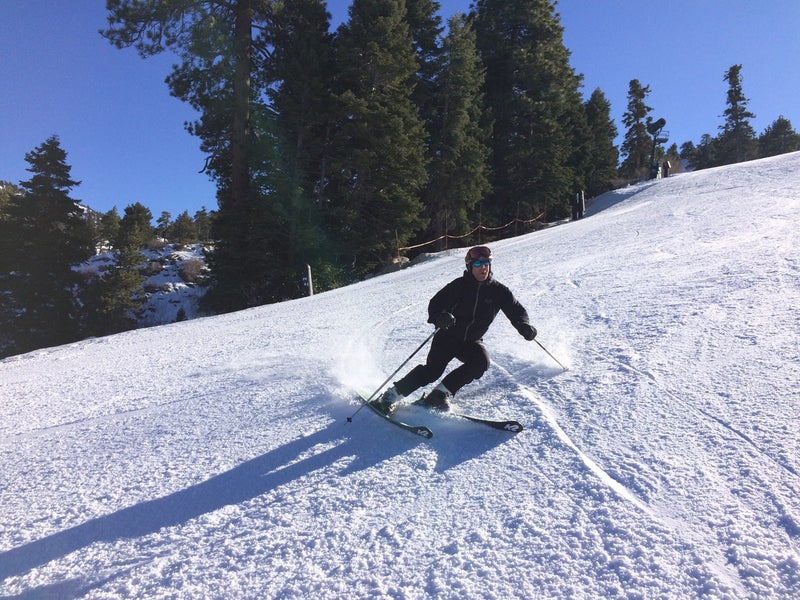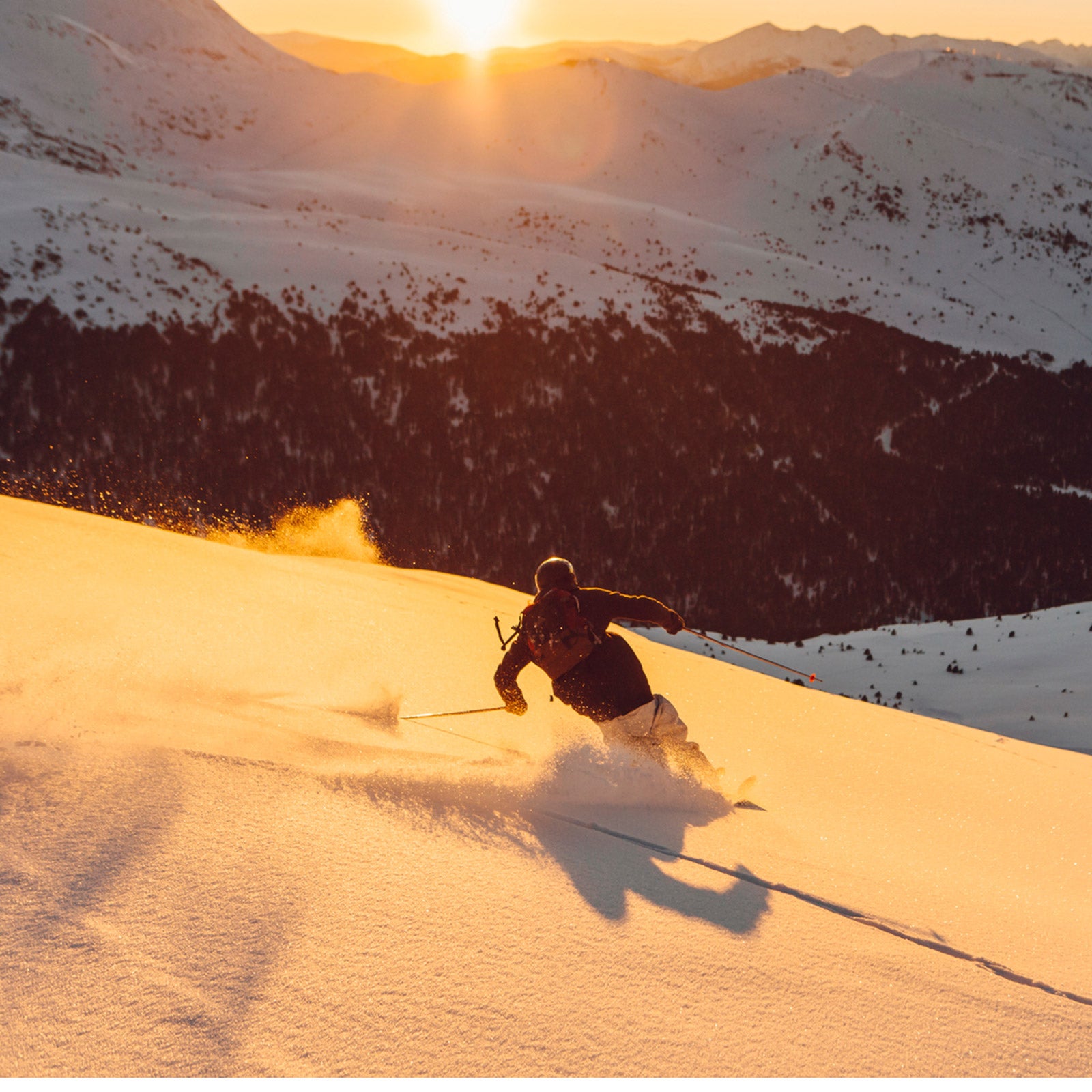I’ve skied for over six decades. I’ve skied dozens of makes and models. I’ve watched ski manufacturers come and go. I’ve witnessed multiple generations of ski technology develop. And I still haven’t found exactly what I want in a ski.
My first pair looked like they’d been excavated from a Scandinavian peat bog—solid wood and nothing close to what��we now call shape.��In 1958, when I was four, my parents jammed my little leather boots into immobile metal brackets called “bear trap” bindings��and launched me down the icy Wisconsin cow pasture that served as our local hill. Lacking basic features such as metal edges, these skis were mainly designed to go straight. Back then��the carved turn was in the experimental phase.
As I sprouted into a proficient skier and then a committed racer, ski design and technique leapt forward at the same time. First came lightweight metals like Howard Head’s revolutionary aluminum and neoprene sandwich, release bindings, and the perfection of the carved turn. As the 21st��century drew closer, the industry exploded with composites, carbon fiber, computer engineering, and shaped��skis. Then came twin tips, fat boys, reverse camber, and many other innovations that allowed the skier to float, spin, fly, and carve��in conditions ranging from deep powder to black ice to artificial grass.
Today’s well-armed (and by necessity, well-heeled) skier boasts a quiver��of skis—pairs to match every snow condition and type of turn, as if coordinating a hand purse to heels before an evening ball. While comparing my first antediluvian set of boards to modern high-performance versions is like comparing a donkey to a fighter jet, the fundamental problem still remains:��I don’t want to mess with a quiver. I want a single pair of planks that do it all.��
This can be a very tall order nowadays. Our standards and expectations have changed so dramatically in the past 60 years. We want everything more perfect, more ordered, and more controlled, forsaking the��pioneering mindset, those days when skiers rigged rope tows powered by old tractors and braved third-degree frostbite to get in a few runs on the local hill. Back then, every ski could do it all—insofar as it could do anything—because only one type of alpine ski existed, and it was long, stiff, and hard to turn. With the myriad refinements since those days, we have myriad expectations of what they can, or should, do for us.
After decades of skiing on hard-carving, hard-snow-only models similar to racing skis—most recently the beefy Nordica Firearrow, with a narrow 84-millimeter waist—I was essentially clueless about today’s all-mountain skis. My first taste of a modern��all-mountain ski convinced me that the perfect pair might actually exist.��
It happened serendipitously. While driving to the West Coast for Thanksgiving in 2018 with my 21-year-old son,��Skyler, and my wife, Amy,��we passed through Idaho and heard that��Grand Targhee had just opened for the season. We��decided to detour for a quick dive into light snow in the Tetons.��
When I asked the veteran ski tech at the local shop for the highest-performance model��it��rented, he set me up on what he called��“a good western all-mountain ski,” the . My pair was��177 centimeters long and had a 96-millimeter waist.
I was skeptical. I’ve long associated all-mountain skis with soft snow. I doubted these could make tight arcs on the hard stuff. From the first turns off the lift, however, I knew I was on something different from anything I’d ever tried. These skis were��far more versatile, so much so that it puzzled me. I thought they��were simply responding to the easy-turning snow. But the harder I cranked them, the better they held the turns on both firm and soft surfaces, as well as big groomers. They even kept me alive and turning when I dropped in behind Skyler in an ungroomed gulley with a few inches of new snow atop a tricky breakable crust.
What’s going on?��I wondered. I’d never been on a pair of skis that did all of these things well.
It was this random experience that launched my season-long search to find the perfect ski—an odyssey that took me from the muscular Tetons��to the chutes of Telluride, Colorado, to the volcanic cone of Oregon’s Mount Bachelor.
But the bulk of the hunt took place at the spire-like Lone Peak thrusting above Big Sky, Montana. Here��my quest took me to one of the annual ski tests hosted by industry manufacturers for shop buyers, where I was guaranteed to find hundreds of pairs to try.
At a reception on the opening evening of the ski test, I bumped into two of my old Montana racing buddies, Bob Anderson and Glenn Gaertner of in Missoula, where I live. When I told them about my mission, they gave me a list that might represent my holy grail—the Experience 94, the Black Ops 98, the Vantage 97, the Enforcer 100, the Bonified 98.
Significantly, each model name was followed by a number that ranged from the mid-nineties to 100. Unlike the one-size-fits-all era of my youth, skis now come in countless width combinations. The width underfoot—the waist—factors crucially in how it performs in different conditions and turns. Many models of skis now use their waist width as an identifier. All-mountain versions tend to range in waist width from roughly 90 to 100 millimeters, with the lower range more effective in firmer snow and often preferred by East Coast skiers, and the higher range often used by those in the Mountain West.��
I also had to overcome a certain prejudice that, as a former racer, I’ve held against skis made for some other purpose than pure,��hard carving. I’m not alone in this. “I know diehards who won’t ski anything over ninety [millimeters]” said Kurt Sundeen, an instructor at Big Sky and a Blizzard rep. “I used to only ski 88’s, and then I smartened up.”
It felt like I had walked into a medieval fair the next morning, as I tromped in my boots through the rainbow mini village of awnings staked in the snow beside the base lodge. I marched up to the Rossignol tent, handed the manufacturer’s rep my official card, which��recorded my binding settings and boot size, and asked to take a run on the .
Snow was falling lightly when I got off the lift, and a soft layer of packed powder and light chop blanketed the runs. I’d chosen the Black Ops to start because Skyler had covetously eyed a pair a few weeks earlier on the rack at Gull Ski and thought they might suit his style: high-speed carving��on hardpack, slamming through moguls, seeking powder and crud in the woods,��all punctuated by the occasional flip.
Although I was skiing on a longer-than-usual (for me) 182-centimeter length, they turned easily, held an edge on a tight giant-slalom carve, and felt cushy and maneuverable in the bumps. Yet they had the rockered tips and tails��for the freeride maneuvers practiced by a younger generation. That may serve Skyler well, it but wasn’t for an old dog like me who wasn’t planning on learning new tricks.��
The former racer in me wanted a pair with an elusive quality I call snap.��By pressuring and arcing the ski through a hard carve, you “load it up with energy,” as they say in the industry, and it launches you out of the turn.
I returned the Black Ops and stomped over to the Elan tent. The reps fitted me out with the . Like shoes, the Ripstick comes with��a right and a left ski, because the inside edge has traditional camber (a ski’s bowed shape, helping it track and hold) and the outside edge features rocker (a more pronounced upturn at the tip and tails, good for maneuverability and playfulness). This asymmetrical configuration lets the Ripstick, as the Elan rep put it, “tip in and out of turns a little easier.”
And these did indeed want to rip. Aiming at a trail’s-edge skirt of light powder, I almost had to rein them in like a young horse eager to run. They traced smooth arcs through swirls of fresh snow and nicely held those long arcs on hardpack, but when I tightened my turning radius, they slightly resisted my efforts to make them carve. The verdict: similar to the Black Ops, certain skiers—especially of a young generation—would love the Ripstick. But for me, the holy grail still lay beyond.
I moved on to Atomic. I’ve been a fan for years and in the early 2000s skied the brand’s Metron, at the time a cutting-edge performance ski. A maker in a country that passionately follows its alpine racers the way Americans follow pro football teams, Austria-based Atomic has serious racing heritage. I clicked into a pair of Vantage Ti 97’s and took a spin. Even skiing them a bit long, they felt both playful and solid, handled the soft snow, and zipped quickly into turns when given tip pressure on hardpack—a classic characteristic of race skis. They could do everything well��but not in a flashy way. As the no-nonsense Austrians might put it, the Atomic Vantage 97 is an extremely competent ski. I put a check mark beside this one.��
At the Nordica tent, the reps convinced me to bypass the bestselling Enforcer 100 and try something “even better”—the��new Enforcer 104, with rocker added to the tail for easier turning. I put these in��league with the Atomic Vantage: both were playful and steady��and felt at home, even graceful, in mixed conditions and chopped-up powder. Likewise, Völkl’s new model of the Mantra (the ski that caught my attention at Targhee), the Mantra 102 felt capable of doing whatever I asked of it quietly, smoothly, and with agility.

As one retailer, Dave Schmidt of the in Kalispell, Montana, had told me at the reception, “Each brand is going to have something that’s hot and not so hot, but overall, everybody is making such good stuff—you’re not going to buy bad quality anymore.”
The next morning, I again made my way��through the village of rainbow awnings. I had a list��and checked my way through it: the , the , the , and the .
I’d tried a pair of last year’s ��and ��earlier in the winter, and they had blown me away with their energy. There was a snap, snap, snap��through the tight turns on hardpack, a longer snaaapp through the GS turns, then a��flick��flick through the moguls. These reacted with a liveliness that I immediately loved, seemed to weigh nothing on my feet, and were up for anything. So I got ahold of this year’s model, the Fischer Ranger 99 Ti. On every turn, they rewarded me. I could make them do whatever I wanted on moguls, they floated on powder with the 99-millimeter waist, and on a hard carve in firm snow, they held an edge like an ice skate, launching me out of one turn into the next. I savor that kind of energy.
The Fischer Ranger 99 Ti has a titanium-alloy layer mid-ski, which yields to carbon fiber at the shovel and tip. The lightweight carbon lowers the swing weight, Fischer’s Mike Hattrup told me, which gives it a light feeling on your��feet. Yet the Ranger 99 also has a classic laminate construction of wood core, fiberglass, and metal-sheet top and bottom, like a “big, fat GS ski,” he said. “That’s probably one of the reasons you like it—it’s supple and damp, with good edge hold.”
Likewise with the Head Kore, which also has a 99-millimeter waist. Deano Uren, a Head rep of 24 years, explained that the Kore has a bit of rocker on the tip and tail��and skied as if it had metal in it,��but that stiffness was due to woven carbon fiber in the layup.��
“You must like Austrian skis,” said Gull’s Bob Anderson when I told him which models had particularly appealed to me. The Fischers and Heads are both made at Austrian factories not far from each other.
My quest could have ended right there, but it didn’t. A few weeks later, while demoing skis on the sprawling sunlit slopes of Mount Bachelor, I also fell in love with the��Kästle FX95 HP��for all the same��head-spinning reasons: carving melded with maneuverability and float. On these skis, I could actually keep up with my 25-year-old daughter, Molly, and her boyfriend, Cody, as they swooped between tight trees. If treed out, I could throw them around in an instant to alter course. A tech in the Mount Bachelor shop said it well: “I call it a freeride carving ski because of the rocker tip.”��
Ultimately, my winterlong quest for the perfect pair landed on that triad: the��Fischer Ranger 99 Ti, the��Head Kore 99, and the Kästle FX95 FP.��All of them have some rocker and special lightweight materials in the tips, camber underfoot, and widths in the mid-to-high nineties. This makes them easy to turn in bumps and��able to hold a hard carve on firm snow, and it gives them float in the powder. What more can you��ask?��
But I had to choose one ski that could do it all. I went with the Fischer Ranger 99, which is��best suited for my style of skiing, my background, and the places and conditions I prefer.��
It’s a great time to be a skier. The technology in the industry has attained a level of sophistication utterly unimaginable when I was growing up. If there’s a perfect ski out there for me, somewhere out there is��a perfect ski for you.��


